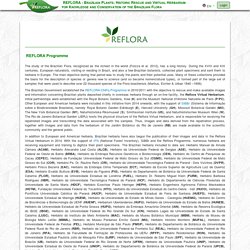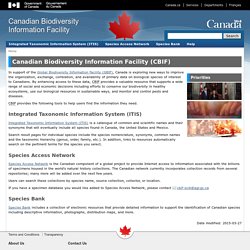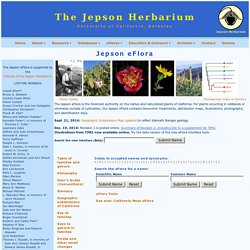

NEON Biorepository Data Portal Image Library. Smithsonian National Ethnobotanical Herbarium Online. Native Plants Database: Audubon. North American Vascular Flora. NEON Biorepository Data Portal Home. The National Ecological Observatory Network - NEON Biodiversity Data Portal is being developed to provide innovative access and discoverability to the entirety of NEON’s sample-based data products; including nearly 40 vertebrate, invertebrate, plant, microbial, and environmental sample collections.

The majority of these samples are physically housed at the Arizona State University Biocollections, located in Tempe, Arizona. Biodiversity portal launched. After twelve long months of preparations, the Caribbean Biodiversity Information Portal has finally been launched.

Reflora; Brazil. The study of the Brazilian Flora, recognized as the richest in the world (Forzza et al. 2012), has a long history.

During the XVIII and XIX centuries, European naturalists, visiting or residing in Brazil, and also a few Brazilian botanists, collected plant specimens and sent them to herbaria in Europe. The main objective during that period was to study the plants and their potential uses. Many of these collections provided the basis for the description of species or genera new to science (and so became nomenclatural types), or formed part of the large set of samples that were used to describe over 22 thousand species of the Flora brasiliensis (Martius, Eichler & Urban 1840 –1906).
The Brazilian Government established the REFLORA/CNPq Programme in 2010/2011 with the objective to rescue and make available images and information concerning Brazilian plants deposited chiefly in overseas herbaria through an on-line facility, the Reflora Virtual Herbarium. Tropicos. Welcome to the Checklist of the Vascular Plants of the Americas website!

¡Bienvenido ~ Bem-vindo ~ Bienvenue ~ Welkom! This list is a work in progress and updates and corrections will be done regularly and posted on this website. We welcome comments and feedback, and extend an invitation to contributors. Reference: Carmen Ulloa Ulloa, Pedro Acevedo-Rodríguez, Stephan Beck, Manuel J. Belgrano, Rodrigo Bernal, Paul E. *Contact: carmen.ulloa@mobot.org Suggested citation for this website: C. Map source: XZise, Wikimedia Commons. Canadian Biodiversity Information Facility (CBIF) In support of the Global Biodiversity Information Facility (GBIF), Canada is exploring new ways to improve the organization, exchange, correlation, and availability of primary data on biological species of interest to Canadians.

By enhancing access to these data, CBIF provides a valuable resource that supports a wide range of social and economic decisions including efforts to conserve our biodiversity in healthy ecosystems, use our biological resources in sustainable ways, and monitor and control pests and diseases. CBIF provides the following tools to help users find the information they need. Integrated Taxonomic Information System (ITIS) Consortium of Midwest Herbaria.
FloraGator: Key for Florida Plants. Minnesota Biodiversity Atlas. The Bell Museum at the University of Minnesota has launched the first web portal providing access to all of its biodiversity collections.

The Minnesota Biodiversity Atlas is an online digital resource offering public access to hundreds of thousands of plant and animal specimens, from algae to zebras. The Atlas–the midwest's first portal to integrate such disparate collections–houses over 5 terabytes of data from the museum's botanical and zoological collections. More than 16,000 species from Minnesota and around the world are represented such as the calypso orchid and the emerald shiner.
"Museums all over are putting their collections online, just as libraries did two decades ago," said Bell Museum scientific director and curator of plants George Weiblen. "The problem is that museums tend to compartmentalize their collections in separate databases–one for mammals, one for birds, etc. PATAGONIA WILDFLOWERS. Indiana Plant Atlas. North American Network of Small Herbaria Home. Small herbaria constitute a major source of information for understanding North America's plant diversity.

These collections are typically regional in scope with strong ecological, taxonomic, and geographic biases. They frequently hold specimens that are unduplicated in larger herbaria and usually represent intense samplings of community composition that significantly expand our knowledge of landscape-level biogeography. As a result, they are singularly important to the study of regionally and nationally significant natural communities. Canadensys. Northern Ontario Plant Database. Susan J.

Meades Sue Meades (left) with team members Danny Sayers (middle) and Derek Goertz (right) at Batchawana River, October 2004. Susan J. Meades, a field botanist with 30 years experience, is the director of the Northern Ontario Plant Database project and does botanical consulting in Newfoundland and Labrador with Jacques-Whitford Envirnment Ltd., St. John's. Derek Goertz Derek Goertz is an Algoma University student earning a Bachelor of Science degree in Biology. Danny Sayers Jr. Danny is a graduate from the Land Management Technician Program at Cambrian College, and has been working in the forestry field for over 20 years. Aaron Mosher. Consortium of California Herbaria: Plants and Lichen of Washington State. Consortium of North American Lichen Herbaria.
The Consortium of North American Lichen Herbaria (CNALH) was created to serve as a gateway to distributed data resources of interest to the taxonomic and environmental research community in North America.

Through a common web interface, we offer tools to locate, access and work with a variety of data, such as keying to species. The CNALH data portal is more than just a web site - it is a suite of data access technologies and a distributed network of universities, botanical gardens, museums and agencies that provide taxonomic and environmental information. Initially created to integrate databases between Arizona State University and the Santa Barbara Botantical Garden, the consortium is growing to extend its network to other partners within North America. Join the Consortium of North American Lichen Herbaria as a regular visitor and please send your feedback to CNALHadmin@asu.edu. Jepson eFlora. The Jepson eFlora is the foremost authority on the native and naturalized plants of California.

For plants occurring in wildlands or otherwise outside of cultivation, the Jepson eFlora contains taxonomic treatments, distribution maps, illustrations, photographs, and identification keys. Sept. 21, 2014: Geographic Subdivisions Map updated to reflect Klamath Ranges geology. Dec. 19, 2014: Revision 2 is posted online. Indiana Plant Atlas.